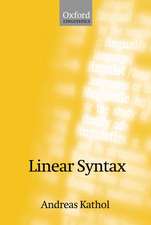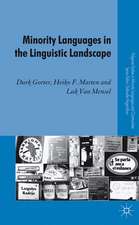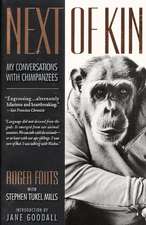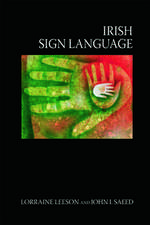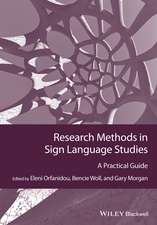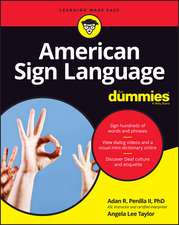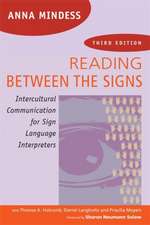Language, Cognition, and the Brain: Insights From Sign Language Research
Autor Karen Emmoreyen Limba Engleză Paperback – noi 2001
These are some of the questions that this book aims at addressing. The answers provide insight into what constrains grammatical form, language processing, linguistic working memory, and hemispheric specialization for language. The study of signed languages allows researchers to address questions about the nature of linguistic and cognitive systems that otherwise could not be easily addressed.
| Toate formatele și edițiile | Preț | Express |
|---|---|---|
| Paperback (1) | 468.11 lei 6-8 săpt. | |
| Taylor & Francis – noi 2001 | 468.11 lei 6-8 săpt. | |
| Hardback (1) | 1120.11 lei 6-8 săpt. | |
| Taylor & Francis – noi 2001 | 1120.11 lei 6-8 săpt. |
Preț: 468.11 lei
Preț vechi: 550.71 lei
-15% Nou
Puncte Express: 702
Preț estimativ în valută:
89.58€ • 93.18$ • 73.96£
89.58€ • 93.18$ • 73.96£
Carte tipărită la comandă
Livrare economică 12-26 aprilie
Preluare comenzi: 021 569.72.76
Specificații
ISBN-13: 9780805833997
ISBN-10: 0805833994
Pagini: 408
Dimensiuni: 152 x 229 x 26 mm
Greutate: 0.65 kg
Ediția:New.
Editura: Taylor & Francis
Colecția Psychology Press
Locul publicării:Oxford, United Kingdom
ISBN-10: 0805833994
Pagini: 408
Dimensiuni: 152 x 229 x 26 mm
Greutate: 0.65 kg
Ediția:New.
Editura: Taylor & Francis
Colecția Psychology Press
Locul publicării:Oxford, United Kingdom
Public țintă
ProfessionalCuprins
Contents: Preface. Introduction. The Structure of American Sign Language: Linguistic Universals and Modality Effects. The Confluence of Language and Space. Psycholinguistic Studies of Sign Perception, Online Processing, and Production. Sign Language Acquisition. The Critical Period Hypothesis and the Effects of Late Language Acquisition. Memory for Sign Language: Implications for the Structure of Working Memory. The Impact of Sign Language Use on Visuospatial Cognition. Sign Language and the Brain. Appendices: Handshapes in American Sign Language. Linguistic Distinctions Among Communication Forms in Nicaragua.
Recenzii
"Written for the general reader with an interest in any of the main topics covered, the book provides introductory linguistic background via a detailed description of American Sign Language and an account of the recent emergence of a new sign language in Nicaragua; myths regarding sign language are debunked; and the demographics and culture of American Sign Language users are outlined."
—LLBA
"This book would be of interest to anyone who wants to understand more about human languages and how the brain processes those languages, although knowledge of ASL and linguistics (especially phonology and morphology) would be helpful. As a second language learner and educator who has spent over 25 years challenged by the nuances and intricacies of ASL, I can honestly say I was fascinated with this book. Some parts were a succinct review of what we already know, some parts presented cutting-edge information, and some parts were quite challenging. Ultimately, however, the book made me think about what I already know and encouraged me to continue exploring how the brain processes language."
—Studies in Second Language Acquistion
—LLBA
"This book would be of interest to anyone who wants to understand more about human languages and how the brain processes those languages, although knowledge of ASL and linguistics (especially phonology and morphology) would be helpful. As a second language learner and educator who has spent over 25 years challenged by the nuances and intricacies of ASL, I can honestly say I was fascinated with this book. Some parts were a succinct review of what we already know, some parts presented cutting-edge information, and some parts were quite challenging. Ultimately, however, the book made me think about what I already know and encouraged me to continue exploring how the brain processes language."
—Studies in Second Language Acquistion
Descriere
Intro to Amer Sign Lang w/ focus on psychological processes involvd in its acquistion & use, as well as the brain bases of ASL. An upper- level txt w/ readership among researchers in cognitve psych & cognitve neuroscience, language & linguistics, speech,


